Day 1 of a three-day long weekend of tour today. We started with a trip down to the Norfolk Broads.
It was a gloriously crisp, frosty, sunny winter’s morning – perfect weather for owls to be out hunting. As we meandered along the coast road, a shape on a post caused us to stop and a quick look confirmed it was a Short-eared Owl. We had a good look at it from the shelter of the car, but when we tried to get the scope out it flew. Thankfully, it was just to start hunting, and it worked its way back and forth across the field.
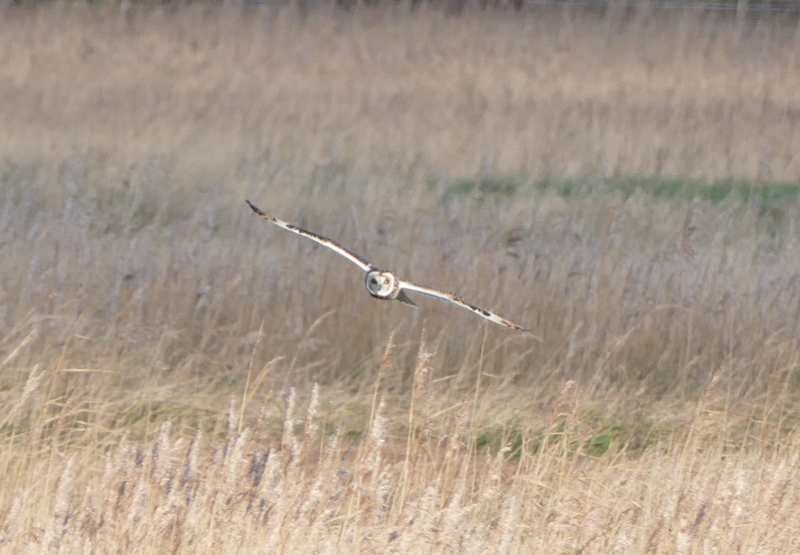 Short-eared Owl – hunting by the coast road
Short-eared Owl – hunting by the coast road
It looked stunning in the morning light as it flew round on stiff wings, focused intently on the ground below. Then it flew back over and landed on one of the posts again.
 Short-eared Owl – landed back on one of the posts
Short-eared Owl – landed back on one of the posts
While we were watching the Short-eared Owl, another owl appeared over the same field, this time a Barn Owl. It was also hunting intently round and round over the rough grass. We didn’t know where to look. Across the other side of the road, a second Barn Owl appeared as well, a couple of fields over. It really was a good morning for owls! We could hear the distant sound of Cranes calling beyond.
 Barn Owl – over the same field as the Short-eared Owl
Barn Owl – over the same field as the Short-eared Owl
Continuing along the coast road, we came across several groups of Pink-footed Geese in the roadside fields. We stopped to scan through them, in the hope that we might find something else in amongst them, but there was nothing with them today. Another field of winter wheat was full of Fieldfares instead, with a single Mistle Thrush in with them.
 Pink-footed Geese – there were several flocks by the road today
Pink-footed Geese – there were several flocks by the road today
We eventually stopped in a convenient layby to scan the fields. We immediately latched on to a pair of Cranes, but they were very distant. We could see them well enough through the scope, although they kept disappearing out of view behind some reeds. A good start, our first Cranes of the morning, but we would hope for some a bit nearer.
There were several Marsh Harriers circling over the reedbed and a Buzzard perched up in a bush catching the morning sun. There were lots of Lapwing out on the grazing meadows and a Turnstone in with them was a bit of a surprise. A flock of Golden Plover were in one of the fields across the road. A good number of Snipe were out in the fields as well this morning, presumably encouraged out to the damper patches in the short grass by the frost.
While we were scanning through all the waders, we were surprised to see two Red Deer stags walk out into the middle of one of the fields. They stood there for a while, steam coming from their nostrils. They seemed to be stranded on the wrong side of one of the ditches, and walked along beside it before finally running off back across the field.
 Red Deer – 2 stags appeared in the fields
Red Deer – 2 stags appeared in the fields
Our next stop was at Winterton. We parked by the beach and walked out onto the sand. There were lots of dog walkers out this morning, presumably taking advantage of the sunny start to the day. As we walked north along the beach, a couple of Ringed Plovers flew past going the other way. A Skylark was singing over the dunes.
The beach itself seemed very quiet today, apart from all the dogs, and there was no sign at first of the Snow Buntings. We got as far as their favourite area and just as we were wondering where they might be, they flew in, about 40 of them, flashing the white in their wings and twittering. They settled just long enough for us to get the scope on them and then they were flushed again. We saw where they had landed and this time we waited for all the dog walkers to go past before we approached. The Snow Buntings were picking around on the edge of the dunes, and we got a much better look at them, until they flew again, back the way they had come.
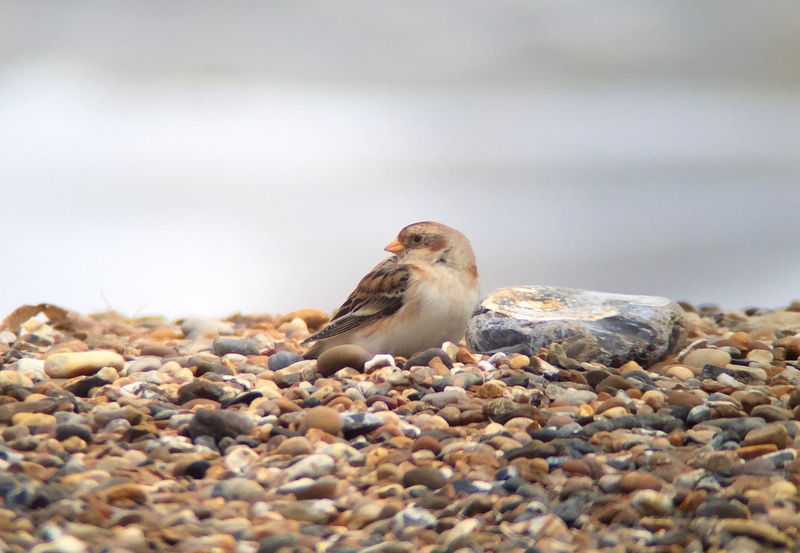
 Snow Buntings – very mobile today, with lots of disturbance on the beach
Snow Buntings – very mobile today, with lots of disturbance on the beach
We made our way back along the beach and stopped to scan the sea. A small party of Gannets were circling offshore. There were also lots of Cormorants, flying past both ways or circling over the sea. As we looked through them, we started to see Red-throated Divers, first a single one, then a couple more, then some small groups. They were all flying north – we must have seen 40-50 go past in the short time we were looking out to sea. A smaller number of Guillemots went past us as well. Seabirds were clearly on the move today.
While we were looking out to sea, we could see some dark clouds in the sky heading our way. We were almost back when it started to rain, but thankfully it was only light. As we drove back inland, we passed through the middle of it and were much happier to be in the car!
We weaved our way inland looking for Cranes. It was hard scanning some of the more distant fields in the rain, but that didn’t matter when we finally got lucky and found a pair of Cranes not too far from the road. We parked in a layby and walked back to where we could see them. The rain had stopped now and they were busy preening at first, presumably having just got wet! Then the smaller female started preening and the male stood with his neck up, giving us a great view of his head pattern.
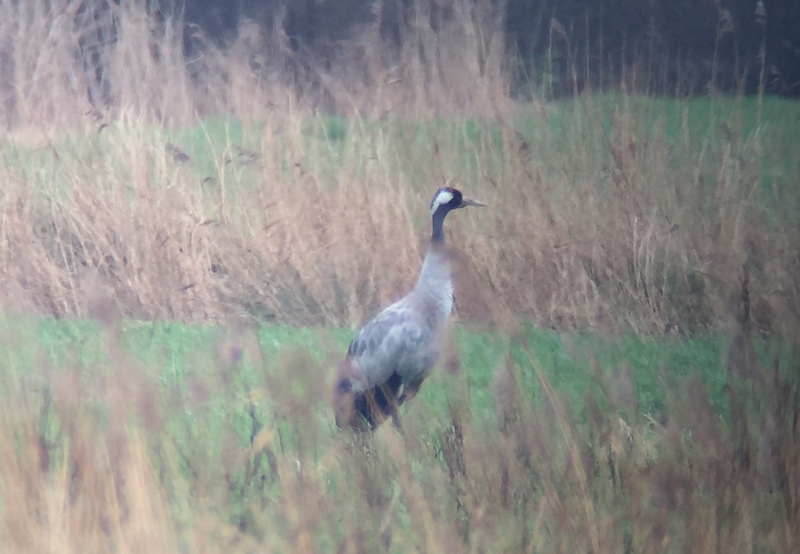 Crane – we finally found a pair not too far from the road
Crane – we finally found a pair not too far from the road
We made our way over to Strumpshaw Fen next, in the hope that the frosty weather might have tempted something out of the reeds. The pool by Reception Hide was still half frozen, and all the ducks were out in the middle – Gadwall, Teal, Mallard and Shoveler – plus a lot of Coots and the resident Black Swan, asleep.
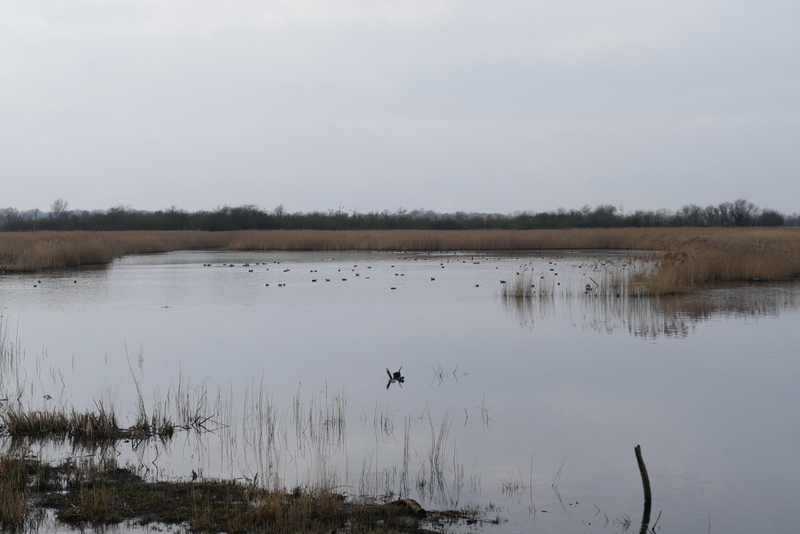 Stumpshaw Fen – the Reception Hide pool was half frozen still
Stumpshaw Fen – the Reception Hide pool was half frozen still
The walk out through the trees was rather quiet, although we did come across a flock of rather flightly Siskin in the alders. There was not much life from Fen Hide either, apart from a single Coot and a rather noisy Carrion Crow. We heard some Bearded Tits calling and a male flew across and landed in the top of the reeds briefly, before dropping down out of sight. A Cetti’s Warbler called from the reeds in front of us, but did not show itself. There was no sign of the hoped-for Bittern, so we decided to move on.
The walk back was a little more productive. Three Bullfinches flew out of the brambles as we approached, flashing their white rumps as they went. A Marsh Tit was picking about in the bushes. A Treecreeper or two were climbing up the trees and a Goldcrest was in the conifers. A couple of Song Thrushes were feasting on ivy berries.
We had enough time for one more site before we needed to be making our way back north, and it was a choice between Buckenham or Cantley. As the former was distinctly quiet and all the geese were at the latter during the week, we headed for Cantley. Unfortunately, the geese were not there today – apart from a few Canada Geese – so we moved swiftly on.
Our next stop was back up at Ludham. The swans were in their usual place, or at least some of them were. Numbers were well down on earlier in the week, particularly of Bewick’s Swans. We could only see 8 Bewick’s Swans today (compared with c65 on Tuesday) with less than 40 Whooper Swans. Bewick’s Swans have been on the move across the county this week, with small groups seen flying towards the coast, so it is possible that a number of them have gone back to the continent already.
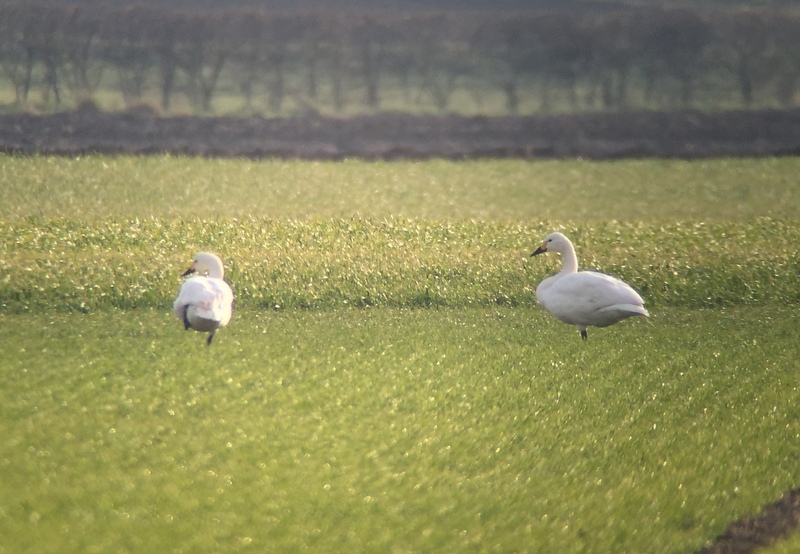 Bewick’s Swans – only 8 today, in with the Whoopers
Bewick’s Swans – only 8 today, in with the Whoopers
Still it was nice to see them side by side, the Bewick’s Swans noticeably smaller in direct comparison. We also admired their bill patterns, with the yellow squared off on Bewick’s Swan compared to the longer, pointed extension of yellow down the bill on Whooper Swan.
 Whooper Swan – still up to 40 today
Whooper Swan – still up to 40 today
Our final stop of the day was at Hickling Broad, where we parked and walked out to Stubb Mill. The walk itself was quiet at first, until we got almost to the mill, when a Short-eared Owl appeared from round the trees. We thought it would do its usual and disappear back round in front of the mill, but today it flew straight towards us and started hunting backwards and forwards over the wet grassland in front of us. Cracking stuff!
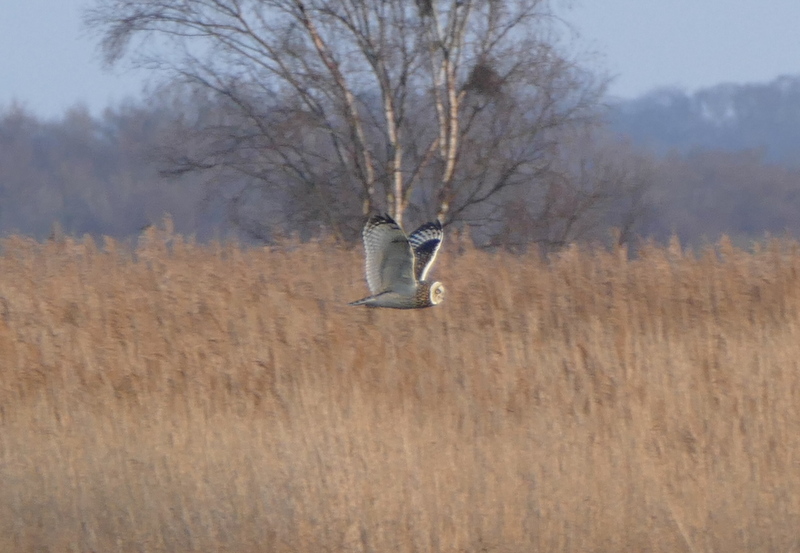 Short-eared Owl – hunting around the back of Stubb Mill
Short-eared Owl – hunting around the back of Stubb Mill
Round at the watchpoint, there was no sign of the two regular Cranes when we arrived. We contented ourselves with watching the Marsh Harriers out in the trees in the reedbed. A ringtail Hen Harrier came in through the trees at the back, but it was a little distant. Two Red Deer, hinds this time, were feeding out on the grass and a third appeared through the reeds further over. A couple of Chinese Water Deer came out of the ditches to graze.
The Short-eared Owl appeared again, this time out in front of the watchpoint. It was hunting at the back of the grazing meadows at first, until suddenly it appeared in the top of one of the bushes quite close to us. We got it in the scope and got some stunning views of it as it looked around. We could really see its bright yellow iris. It stayed in the same place for an age – every time we looked back, it was still perched in the bush. A Barn Owl was also out hunting, at the back of the fields.
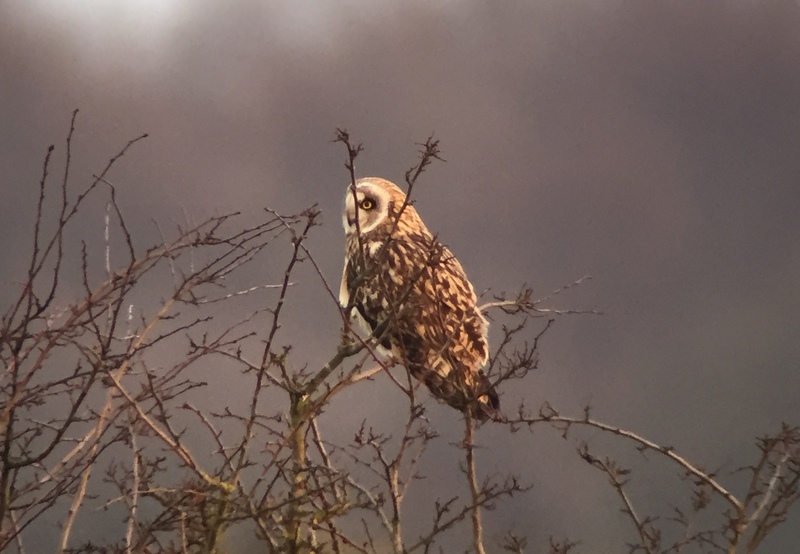 Short-eared Owl – perched in one of the bushes in front of the watchpoint
Short-eared Owl – perched in one of the bushes in front of the watchpoint
While we were watching the Short-eared Owl, three Cranes appeared overhead, flying past. We didn’t know which way to look! They called as they flew. Then another pair of Cranes flew in from the back and dropped down into the reeds.
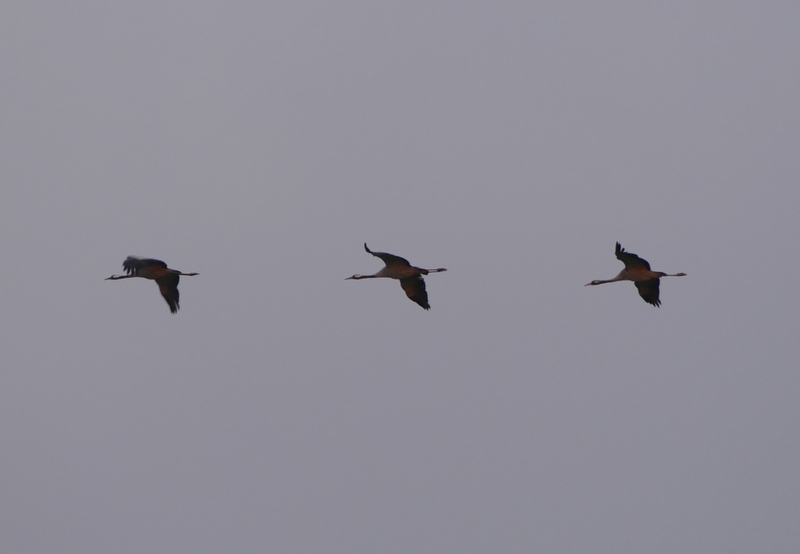 Cranes – flew past the watchpoint calling
Cranes – flew past the watchpoint calling
While we were watching the pair of Cranes, another ringtail Hen Harrier flew across the scope view in the foreground. This one was much closer than the one we had seen earlier and we got a much better look at it, flashing its square white rump patch as it went. Finally the normally resident pair of Cranes flew in from the left (taking the total to 11 Cranes for the day) and across in front of us, as the light started to fade. They were calling all the way, as they dropped down onto the ground, a beautiful sound and a fitting way to end the day.
















